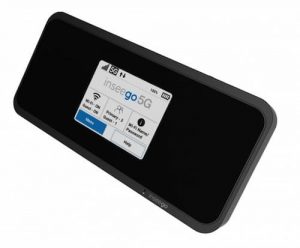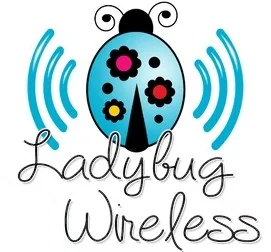How to Get Wi-Fi While Camping
Answer the call of the wild and emails with equal ease.
Dec 3, 2025 | Share
Technology
-
Best for short tripsCell phone hotspotOur pick: Visible Prepaid cellular plan
- $25.00-$45.00/mo.
- Unlimited data
- No contracts
- Wide coverage
-
Best for glampingMobile HotspotOur pick: T-Mobile Inseego 5G MiFi M2000
- $299.99†
- 5G Connection
- Wi-Fi 6
- Up to 30 Wi-Fi enabled devices supported
-
Best for work campingPortable 4G internetLadybug Wireless Internet
- $124.99–$219.99/mo.
- 300GB/mo.–Unlimited data
- Multiple networks
- Portability options
-
Best for the comforts of homePortable satellite internetOur pick: Starlink Roam Unlimited
- $165/mo.*
- Speeds up to 300Mbps
- Nationwide coverage
- In-Motion use option
Data as of 12/03/2025. Offers and availability may vary by location and are subject to change.
* Plus hardware, shipping & handling fees, and tax. Fully refundable. Depending on location, some orders may take 6 months or more to fulfill.
The best way to stay connected while camping is using internet over cellular networks. Most people don’t spend much time online while camping, but sometimes you need to stay connected, even when you’re off having an adventure.
In some cases, the ability to stay connected while out in nature can give you more opportunities to get out of the house. Whatever your circumstances, here are our tips on how to get internet service in the great outdoors.
On this page:
Best internet for camping | How to choose | Phone hotspots | Mobile hotspots | Portable 4G LTE | Portable Satellite | Tips for camping internet | Our verdict | FAQ
On this page:
Best internet options for camping
| Product | Price | Data cap | Order online | |
|---|---|---|---|---|
| Best for short trips | Visible | $25.00–$45.00/mo. | Unlimited data | View Plan |
| Best for glamping | T-Mobile Inseego 5G MiFi M2000 | $299.99† (plus data plan) | 2–100 GB/mo. (depending on plan) | View on Amazon |
| Best for workamping | Ladybug Internet | $124.99–$219.99/mo. | 300 GB/mo.–Unlimited data | View Plan |
| Best for the comforts of home | Starlink Roam Unlimited | $165/mo.* | 1 TB | View Plan |
Data as of 5/27/2025. Offers and availability may vary by location and are subject to change.
*Plus hardware, shipping & handling fees, and tax. Fully refundable. Depending on location, some orders may take 6 months or more to fulfill.
How to pick the right internet solution for your camping needs
What kind of camping you do and how much you rely on a strong internet connection dictate which mobile internet type is best for you. Depending on the intensity of your online activities and the frequency of your camping, internet solutions fall into three main categories:
Hotspot phone plans—If all you need is a way to connect to Spotify when you’re out roasting marshmallows on the weekends, you probably don’t need an elaborate setup. The best option is going with a phone plan that gives you unlimited hotspot data, or at least unlimited phone data with a high data cap when acting as a hotspot.
Mobile hotspots—For those who use multiple internet-connected devices on their trips, a dedicated mobile hotspot is a reliable choice that doesn’t tie up your phone. A hotspot requires its own SIM card and data plan, so this option is best for frequent campers.
Portable 4G internet service—For those who need a long-term solution capable of doing most online activities, portable 4G internet service is the way to go. There are quite a few 4G internet options for those working a 9-to-5 job out in the wilderness. They can give you the speedy and reliable connection you need for work, school, or whatever else you might need.
Mobile satellite internet—If you want the highest speeds available anywhere you go, satellite internet might be your best option. Starlink recently announced Starlink Roam Unlimited, its new portable satellite system. With a satellite connection, Roam Unlimited offers reliable service, no matter how far you trek into the wilderness. It also offers higher speeds than 4G connections. As an additional perk, Roam Unlimited allows in-motion use of the system for those who upgrade to its High Performance equipment, though the upgrade is a pretty big investment.
Pro Tip:
Since actual download speeds often depend both on which network you use and where you’re trying to use it, many mobile internet providers simply advertise “4G speeds.” In general, 4G speeds run about 28–35 Mbps, but this can go up in more urban areas and down in more remote ones.1
Best for short trips—Visible
Price: $25.00–$45.00/mo.
- Unlimited data
- No contracts
- Wide coverage
If you like to get away on the weekends but want to stay connected, your mobile phone plan may be your best bet, especially if you have unlimited data and hotspot tethering.
This is a convenient option that makes use of things you probably already have, so it doesn’t require a large investment. In fact, if you already use a lot of data while camping, switching to an unlimited data plan could save you a lot of money by eliminating overage charges.
Visible is an excellent phone plan for unlimited data. It lets you not only run data-heavy apps on your phone without worry, but also use your phone as a hotspot to connect another device like a laptop to the internet.
The downside of Visible is that hotspot data speeds are capped at 5Mbps, 10Mbps, or 15 Mbps, depending on your plan. While it’s great for posting pictures to Instagram or listening to Spotify, it’s not well suited to getting out a laptop and watching Netflix.
One important factor in choosing a phone plan for camping is the provider’s coverage area. Most phone plans use AT&T, Verizon, or T-Mobile’s cellular networks to deliver service. All three of them are nationwide, but coverage areas vary, especially in more remote areas. Before choosing a plan, make sure its network covers the areas you most frequently visit. Visible runs on the Verizon network.
 Pros:
Pros:
- Unlimited data
- Low monthly cost
 Cons:
Cons:
- Slow speeds
Best cell phone plans for camping
| Plan | Price | Data cap | Hotspot data | Order online |
|---|---|---|---|---|
| Visible | $25.00–$45.00/mo. | Unlimited | Unlimited (at 5 Mbps) | View Plan |
| T-Mobile Go5G Plus | $90.00/mo. | Unlimited | 50 GB (then reduced to 3G speeds) | View Plan |
| Verizon Do More Unlimited | $80.00/mo. | 50 GB | 15 GB (then reduced speed) | |
| AT&T Unlimited Extra | $75.00/mo.* | Unlimited | 30 GB |
Data effective 05/15/25. Offers and availability may vary by location and are subject to change.
* 5G coverage not available everywhere. Requires compatible device/service. Other terms and restr’s apply. Data charges may apply.
Best for glamping—T-Mobile Inseego 5G MiFi M2000
Price: $299.99*
- 5G connection (4G LTE backup)
- Wi-Fi 6
- USB-C Port
- Up to 30 Wi-Fi Enabled Devices supported
Glamping is an increasingly popular way for people to enjoy nature while also enjoying many of the amenities you might expect in a hotel or resort. Many glamping locations come with Wi-Fi, similar to a traditional hotel, but this isn’t a given, especially in smaller locations.
If you want to make sure you can always get online without relying on the site to have Wi-Fi, a mobile hotspot like the Inseego 5G MiFi M2000 may be your best answer.
Much like your smartphone, wireless hotspots connect to cellular networks to access the internet. They then put out a Wi-Fi signal for your devices to use. In contrast to using your phone as a hotspot, a hotspot is designed specifically for the task, allowing faster speeds and more connected devices. Hotspot data plans also usually give you more data at a lower price compared to phone plans, which often specifically restrict hotspot data.
The Inseego 5G MiFi M2000 is one of the best hotspots on the market. Although some hotspots allow you to use SIM cards from any carrier, the M2000 uses only T-Mobile’s network; however, the default plan for the M2000 comes with 100 GB of data for just $50 per month—a pretty great deal.
The M2000 also comes with Wi-Fi 6, the most recent and most powerful Wi-Fi standard. Wi-Fi 6 can handle a large number of devices on its network without slowing, which means that even if the place you stay has internet, your Wi-Fi might actually be better.
 Pros:
Pros:
- 5G connection
- Multiple devices supported
 Cons:
Cons:
- T-Mobile exclusivity
- Limited 5G availability
Data effective 2/25/22. Offers and availability may vary by location and are subject to change.
Best mobile hotspots
| Product | Price* | Network | Max devices | Order online |
|---|---|---|---|---|
| Inseego 5G MiFi M2000 | $299.99 | T-Mobile | 30 | View on Amazon |
| NETGEAR AC797 4G LTE Mobile Hotspot | $139.00 | Any | 15 | View on Amazon |
| Alcatel LINKZONE | $69.99 | Any | 16 | View on Amazon |
Data as of 2/28/2022. Offers and availability may vary by location and are subject to change.
Best for work camping—Ladybug Internet
$124.99–$219.99/mo.
Specs:
- Unlimited data
- T-Mobile, AT&T or Verizon network
- 4G and 5G options
With more and more workplaces switching to remote work, online workers have been making the most of this flexibility by packing up their laptops and heading out on adventures any day of the week.
Portable 4G internet has long been a staple for digital nomads, but those taking the first steps into remote work, this flexible technology can provide speeds and reliability comparable to many wired types of internet, so you can work from anywhere with cell reception.
The downside is that portability comes with a price—these plans are considerably more expensive than home 4G plans that require a fixed location.
Ladybug Internet is a great option for remote flexibility. It allows you to connect using any of the three major cellular networks. It requires no contracts or installation. It has multiple plan options with both 4G and 5G speeds. They even have options for international travel. The only downside is that since all their plans are prepaid with no contract, you also have to purchase your modem upfront, which can make the initial switch pretty difficult.
 Pros:
Pros:
- No contract
- Unlimited data
 Cons:
Cons:
- Inconsistent speeds
- Higher costs than fixed 4G
Best for the comforts of home—Starlink Roam Unlimited
Price: $165/mo.*
- Speeds up to 300Mbps
- Nationwide Coverage
- In-motion use option
- 1 TB data cap
Starlink Roam Unlimited customers can take their dish with them to connect to the internet as they travel. Roam Unlimited comes in either a regional plan that costs $150 per month or a global plan that costs $200 per month. The regional plan comes with the additional perk of offering in-motion service for those using either Starlink’s Flat High Performance equipment (which is very expensive) or the new Starlink Roam 50GB (which is much cheaper, but still twice the cost of a hotspot). It’s also the cheaper of the two. In-motion service means that you not only have reliable internet when you get to your destination, but also while you’re on the road.
Roam Unlimited’s monthly cost is comparable to portable 4G plans, but offers much higher speeds. A better option for weekend campers is to get Starlink’s Mini Roam plan. It only provides 50GB of data, but the plan will only cost you $50 each month and can be paused when you don’t need it.
The biggest issue is the upfront equipment cost. The Mini is the same price as Standard Starlink equipment, with a one-time cost of $599, which is already expensive when compared with other providers. The Flat High Performance equipment costs $2,500, which is prohibitively expensive and not really practical for a camping trip.
Starlink Roam Unlimited is an amazing service for a very specific niche. If you need fast, reliable internet while you’re on the road, Roam Unlimited can be a game changer. For most of us, a fast connection on the highway isn’t worth several hundred (or thousand) dollars. As cool as it may be, there are much cheaper options that can still deliver a decent online experience.
 Pros:
Pros:
- Widest possible coverage
- High data cap
- In-motion use option
 Cons:
Cons:
- High upfront equipment costs
- Delays in equipment delivery
Data as of 8/12/2024. Offers and availability may vary by location and are subject to change.
*Plus hardware, shipping & handling fees, and tax. Fully refundable. Depending on location, some orders may take 6 months or more to fulfill.
Best portable 4G LTE and satellite internet
| Plan | Price | Networks | Data cap | Order online |
|---|---|---|---|---|
| Ladybug Wireless | $124.99–$219.99/mo. | AT&T T-Mobile Verizon | 300GB–Unlimited | View Plan |
| Nomad Internet | $129.00–$149.00/mo. | T-Mobile Verizon | Unlimited | View Plan |
| Starlink Roam Unlimited | $165/mo. (plus onetime $499.00 or $1,900.00 equipment fee)* | Starlink | 1 TB | View Plan |
| UbiFi | $99.00/mo. | AT&T | Unlimited | View Plan |
Data as of 5/27/2025. Offers and availability may vary by location and are subject to change.
*Plus hardware, shipping & handling fees, and tax. Fully refundable. Depending on location, some orders may take 6 months or more to fulfill.
Considerations for internet while camping
Data caps and coverage area are incredibly important when camping. Being out in the wilderness requires some forethought. For example, nationwide 4G networks cover the majority of the US, but there are a lot more dead zones in unpopulated areas (like where you might go on a camping trip).
As such, there is no perfect solution that works no matter where the wind takes you. Rather, it’s always a balancing act between how much speed and reliability you need, where you want to go, and how much you’re willing to spend. It’s pretty easy to find a way to post selfies on a weekend trip, but it’s much harder to work a full-time job from the middle of a national forest.
It’s also important to keep your options open and look for novel solutions. Instead of trying to find a dedicated 4G plan that can allow you to work everywhere you want to travel or choosing a satellite plan to guarantee total coverage, you might be able to get by with just a phone plan—as long as you can stop at a nearby coffee shop anytime you have an important meeting.
Camping generally involves giving up the comforts of civilization for a few days, but if you know what you’re doing, you can keep just enough contact with the rest of the world that you can truly relax while you’re out in nature.
Dealing with data caps
No one likes data caps, and they’re a much more common issue with wireless internet compared to wired home internet. It’s surprisingly easy to burn through terabytes worth of data per month with normal activities like watching Netflix, so we generally suggest going with an unlimited data plan if you have access to one.
If you have minimal internet needs or have occasional access to free Wi-Fi on your trips, it’s possible to make due with a cheaper plan with a restrictive data cap. Just remember to be disciplined about your internet use because overage charges can negate any savings you made very quickly.
Campground Wi-Fi
You’re not the only one who likes to stay connected while out camping. Many campgrounds, including big chains like KOA, offer public Wi-Fi to guests. This might be all you need on your camping trip, but even if you need a more flexible solution, connecting to campground Wi-Fi periodically can help you save on data usage or give you faster speeds when you need them.
Campground Wi-Fi isn’t always the most reliable, especially if it’s crowded. To get the most out of your Wi-Fi connection, try to pick a spot near the transmitter that doesn’t have any major obstructions like trees blocking line-of-sight.
If you’re not staying at a Wi-Fi-enabled campground, there are lots of other places with public Wi-Fi you can use:
- Coffee shops
- Diners
- Fast-food restaurants
- National Park Visitor Centers
- Truck stops
Internet access is such a basic necessity these days that you can probably find it in a lot more places than you might think. For more tips, check out our guide on how to find Wi-Fi hotspots.
Choosing a 4G network
Many 4G devices let you choose which wireless carrier you want to use. The three major carriers, AT&T, Verizon, and T-Mobile, all have nationwide networks that cover most cities in the US but have significant holes in coverage, which get bigger the more remote your location is.
If you have specific locations you know you want to visit, consult each provider’s website to see which one covers those areas best. Although there used to be a clear winner in terms of the largest 4G network, all three are currently neck and neck, so it’s likely that you can make due with whichever you want.2
It’s worth noting that some services that let you choose your network have different monthly costs depending on which one you choose. Unless you frequent an area that is covered by a specific carrier, it’s probably best to choose the cheapest network your 4G provider offers.
Our verdict
Unless you have one place where you camp on a regular basis, your internet experience is going to vary a lot from place to place. As such, we suggest going with the cheapest and easiest option that will meet your needs.
Although having a fast, reliable source of internet to take on your adventures can open up a lot of new opportunities, you can often get by with just a phone and a bit of ingenuity.
Internet for Camping FAQ
Should I get a 5G internet plan?
Can you get internet without cell service?
Sources
- Francesco Rizzato, Opensignal, “Mobile Network Experience Report,” July 2021. Accessed February 28, 2022.
- Francesco Rizzato, Opensignal, “Mobile Network Experience Report,” January 2022. Accessed February 28, 2022.
Disclaimer
Product prices and availability are accurate as of the date/time indicated and are subject to change. Any price and availability information displayed on Amazon.com at the time of purchase will apply to the purchase of this product. HighSpeedInternet.com utilizes paid Amazon links.
CERTAIN CONTENT THAT APPEARS ON THIS SITE COMES FROM AMAZON. THIS CONTENT IS PROVIDED ‘AS IS’ AND IS SUBJECT TO CHANGE OR REMOVAL AT ANY TIME.
Author - Peter Christiansen
Peter Christiansen writes about telecom policy, communications infrastructure, satellite internet, and rural connectivity for HighSpeedInternet.com. Peter holds a PhD in communication from the University of Utah and has been working in tech for over 15 years as a computer programmer, game developer, filmmaker, and writer. His writing has been praised by outlets like Wired, Digital Humanities Now, and the New Statesman.
Editor - Rebecca Lee Armstrong
Rebecca Lee Armstrong has more than six years of experience writing about tech and the internet, with a specialty in hands-on testing. She started writing tech product and service reviews while finishing her BFA in creative writing at the University of Evansville and has found her niche writing about home networking, routers, and internet access at HighSpeedInternet.com. Her work has also been featured on Top Ten Reviews, MacSources, Windows Central, Android Central, Best Company, TechnoFAQ, and iMore.






